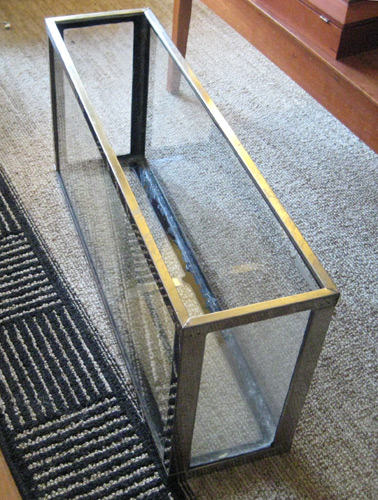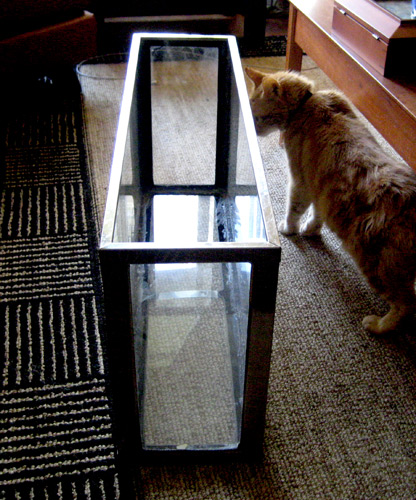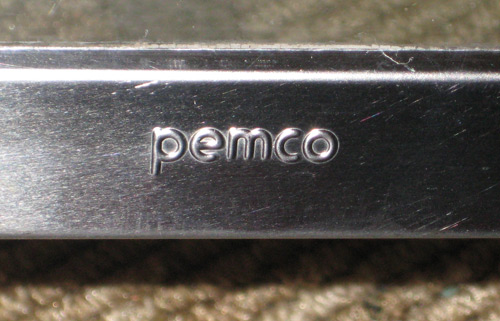Long and skinny:

Old kitty inspected:

Pemco:

I'm restoring my 100g Metaframe first, but this one is now number two.
Rick (19 tanks, and counting...)
Posted 13 February 2010 - 08:00 PM



Posted 13 February 2010 - 08:49 PM
Posted 13 February 2010 - 09:13 PM
Posted 13 February 2010 - 11:53 PM
Posted 14 February 2010 - 11:28 PM
Posted 25 February 2010 - 10:48 AM
Posted 25 February 2010 - 04:36 PM
Edited by mikez, 25 February 2010 - 04:38 PM.
Posted 25 February 2010 - 04:40 PM
Posted 26 February 2010 - 12:16 AM
I've never gotten a metal frame that didn't leak. Whats your sealing technique?
You want RETRO? I saw a cool one on the WaterWolves site. Really odd looking and the stand had seahorses for legs.
Posted 26 February 2010 - 09:39 AM
I've seen some horrendous attempts at reseals. Great globs of milky silicone, often with bits of gravel or sand embedded, looking like it was applied by drunken monkeys equipped with mops.
Posted 26 February 2010 - 12:52 PM
Posted 26 February 2010 - 11:14 PM
I've been looking for that "tank tar" recipe for months!
-a cool darter tank would be about that height and width, but about 6 or even 10 feet long.
Posted 28 February 2010 - 04:38 PM
Posted 02 March 2010 - 06:00 AM
Posted 02 March 2010 - 04:34 PM
Depending on the tank... I've done full "old school" restorations on a couple of small metal framed tanks. I found a recipe for the original tar goop out of an old Innes book (pg. 490, 1944 edition of 'Exotic Aquarium Fishes'). The first two paragraphs are the recipe I used. The second recipe used powdered lead, among other things...
The way leaking old stainless slate/tar tanks used to be "resealed" was to put them in the bathtub and fill them with -hot- water. This still works, sometimes, but after 40, 50 years, the tar goop is often just too dried out to soften up enough to reseal.
Simply resealing all the inner seams in a slate bottom tank with silicone isn't a great solution, as silicone doesn't stick to slate very well. It might work, it might not. I've seen some horrendous attempts at reseals. Great globs of milky silicone, often with bits of gravel or sand embedded, looking like it was applied by drunken monkeys equipped with mops. The tank I'm going to use as a darter tank has had a drunken monkey silicone reseal. Razor blades are your friend at this point.
When I rebuild a stainless tank for my personal use, I generally replace at least the front glass, after 40 years, it surely has a ton of scratches. And I use silicone rather than tar to reseal. So I also replace the slate bottom with a piece of thick plate glass. To disassemble, use a heat gun to slowly heat up the tar in the frame, and slip a putty knife between the glass and frame all the way around. It takes a while, and you can't pry, the slate and glass has to ooze loose on it's own or else it will break. Use a heat gun and paint stir stick to get as much tar out of the frame as possible. Then, can(s) of carb cleaner and brush to get the residue off. It takes a while and is stinky, tedious work.
To reassemble, I bed and seal using black silicone, which gives the tank an original look.
Once the tank is done, I take the left over original slate bottom, clean it off, round the corners a bit and sand the edges smooth. It gets set, loose, in the bottom of the tank, on top of a thin layer of closed cell foam, added protection for the glass bottom from heavy rocks. Shot of a pico with the slate laid on foam on the bottom.
I was after a very nice deco Jewel aquarium on eBay a few weeks ago but missed it. The deco tank on WaterWolves is a repop of a BIG Jewel tank. Very cool looking.
Rick
0 members, 1 guests, 0 anonymous users